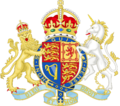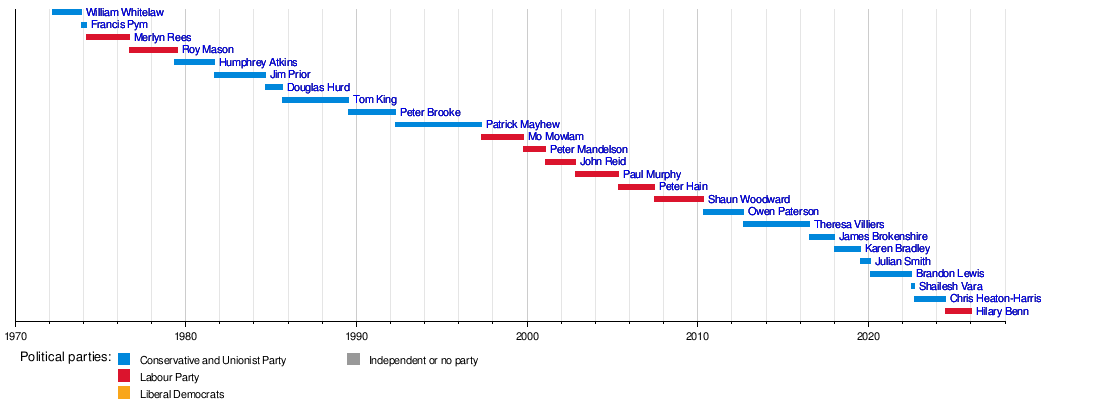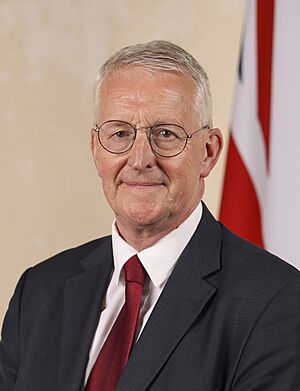Secretary of State for Northern Ireland facts for kids
Quick facts for kids United KingdomSecretary of State for Northern Ireland |
|
|---|---|

|
|
| Office of the Secretary of State for Northern Ireland | |
| Style | Northern Ireland Secretary (informal) The Right Honourable (within the UK and Commonwealth) |
| Member of | |
| Reports to | The Prime Minister |
| Residence | Hillsborough Castle |
| Seat | Westminster |
| Nominator | The Prime Minister |
| Appointer | The Monarch
(on the advice of the Prime Minister)
|
| Term length | At His Majesty's pleasure |
| Precursor | Lord Lieutenant of Ireland Governor of Northern Ireland |
| Formation | 24 March 1972 |
| First holder | William Whitelaw |
| Deputy | Minister of State for Northern Ireland |
| Salary | £159,038 per annum (2022) (including £86,584 MP salary) |
The Secretary of State for Northern Ireland is a very important government official in the Government of the United Kingdom. This person is in charge of the Northern Ireland Office, which is a government department. They are also a member of the Cabinet of the United Kingdom, which is a group of the most senior ministers in the government. The current Secretary of State for Northern Ireland is Hilary Benn.
This official works closely with other ministers in the Northern Ireland Office. There is also a "shadow minister" who is part of the main opposition party. This shadow minister watches what the Secretary of State does and offers different ideas.
Contents
History of the Role
For a long time, different officials were in charge of Irish affairs in the UK Government.
- The Lord Lieutenant of Ireland was in charge from around 1171 to 1922.
- The Chief Secretary for Ireland held power from 1560 to 1922.
- After 1922, the Home Secretary was responsible until 1972.
For example, in August 1969, the Home Secretary at the time, James Callaghan, approved sending British Army soldiers to Northern Ireland. While Scotland and Wales had their own Secretaries of State, Northern Ireland was different. It had its own local government and parliament at Stormont.
Why the Role Was Created
The job of Secretary of State for Northern Ireland was created in 1972. This happened after the local government in Northern Ireland was stopped because of a lot of public unrest. The British government felt that the Stormont government was losing control. So, on March 30, 1972, the UK Parliament in Westminster took direct control.
The new Secretary of State took over three important roles that existed before:
- The governor of Northern Ireland: This person was the official head of the government and represented the British monarch.
- The prime minister of Northern Ireland: Today, this role is shared by the first minister of Northern Ireland and the deputy first minister.
- The minister of home affairs: This role is now similar to the minister of justice.
Direct rule was meant to be a temporary solution. The goal was to have a power-sharing government in Northern Ireland again. This direct rule was voted on and renewed by Parliament every year.
Steps Towards Peace
In 1973, the Sunningdale Agreement led to a short-lived power-sharing government called the Northern Ireland Executive. It started on January 1, 1974, but ended on May 28, 1974. This happened because of a strike by loyalist workers. They did not like the idea of power-sharing or the links with the rest of Ireland.
Later attempts to bring back local government, like the Northern Ireland Constitutional Convention (1975–1976) and the Northern Ireland Assembly (1982–1986), were not successful. However, after the Anglo-Irish Agreement on November 15, 1985, the UK and Irish governments started working more closely together.
A big step forward was the Belfast Agreement, also known as the Good Friday Agreement, on April 10, 1998. This agreement brought back local government to Northern Ireland on December 2, 1999. This meant that many of the Secretary of State's duties were given to local politicians in the Northern Ireland Executive.
The Role Today
Because of this devolution, the Secretary of State's role has changed. Many powers that used to belong to them are now handled by the Northern Ireland Assembly and the Northern Ireland Executive.
Today, the Secretary of State mainly represents Northern Ireland in the UK cabinet. They also make sure the local government is working well. Some matters, like security, human rights, and elections, still remain under the UK Government's control.
Since 1972, the position has been held by members of either the Conservative Party or the Labour Party. These Secretaries of State do not represent a constituency in Northern Ireland. This is different from the Secretaries of State for Scotland and Wales.
The official home of the Secretary of State is Hillsborough Castle. This castle used to be the home of the governor of Northern Ireland. It is also still a royal residence for the monarch in Northern Ireland. The Secretary of State gets help from the Northern Ireland Office (NIO) to do their job.
Periods of Suspension
The local government in Northern Ireland was stopped several times. For example, it was suspended between October 15, 2002, and May 8, 2007. This happened because some parties, like the Ulster Unionist Party and Democratic Unionist Party, found it difficult to be in government with Sinn Féin. During these times, the Secretary of State and their ministers took back control of the region. They also worked hard to negotiate with all parties to bring back the local government.
Power was given back to the Northern Ireland Assembly on May 8, 2007. The Secretary of State kept control over policing and justice until most of those powers were also given to the local government on April 12, 2010.
List of Secretaries of State for Northern Ireland
Colour key
Conservative Labour
| Secretary of state | Term of office | Party | Prime Minister | ||||
|---|---|---|---|---|---|---|---|
 |
William Whitelaw MP for Penrith and The Border |
24 March 1972 | 2 December 1973 | Conservative | Edward Heath | ||
 |
Francis Pym MP for Cambridgeshire |
2 December 1973 | 4 March 1974 | Conservative | |||
 |
Merlyn Rees MP for Leeds South |
5 March 1974 | 10 September 1976 | Labour | Harold Wilson | ||
 |
Roy Mason MP for Barnsley |
10 September 1976 | 4 May 1979 | Labour | James Callaghan | ||
 |
Humphrey Atkins MP for Spelthorne |
5 May 1979 | 14 September 1981 | Conservative | Margaret Thatcher | ||
 |
Jim Prior MP for Lowestoft (until 1983) MP for Waveney (from 1983) |
14 September 1981 | 11 September 1984 | Conservative | |||
 |
Douglas Hurd MP for Witney |
11 September 1984 | 3 September 1985 | Conservative | |||
 |
Tom King MP for Bridgwater |
3 September 1985 | 24 July 1989 | Conservative | |||
 |
Peter Brooke MP for Cities of London and Westminster South |
24 July 1989 | 10 April 1992 | Conservative | |||
| John Major | |||||||
 |
Patrick Mayhew MP for Tunbridge Wells |
10 April 1992 | 2 May 1997 | Conservative | |||
 |
Mo Mowlam MP for Redcar |
3 May 1997 | 11 October 1999 | Labour | Tony Blair | ||
 |
Peter Mandelson MP for Hartlepool |
11 October 1999 | 24 January 2001 | Labour | |||
 |
John Reid MP for Hamilton North and Bellshill |
25 January 2001 | 24 October 2002 | Labour | |||
 |
Paul Murphy MP for Torfaen |
24 October 2002 | 6 May 2005 | Labour | |||
 |
Peter Hain MP for Neath (also Welsh Secretary) |
6 May 2005 | 28 June 2007 | Labour | |||
 |
Shaun Woodward MP for St Helens South |
28 June 2007 | 11 May 2010 | Labour | Gordon Brown | ||
 |
Owen Paterson MP for North Shropshire |
12 May 2010 | 4 September 2012 | Conservative | David Cameron (Coalition) |
||
 |
Theresa Villiers MP for Chipping Barnet |
4 September 2012 | 14 July 2016 | Conservative | |||
| David Cameron (II) |
|||||||
 |
James Brokenshire MP for Old Bexley and Sidcup |
14 July 2016 | 8 January 2018 | Conservative | Theresa May (I) |
||
| Theresa May (II) |
|||||||
 |
Karen Bradley MP for Staffordshire Moorlands |
8 January 2018 | 24 July 2019 | Conservative | |||
 |
Julian Smith MP for Skipton and Ripon |
24 July 2019 | 13 February 2020 | Conservative | Boris Johnson (I) |
||
| Boris Johnson (II) |
|||||||
 |
Brandon Lewis MP for Great Yarmouth |
13 February 2020 | 7 July 2022 | Conservative | |||
 |
Shailesh Vara MP for North West Cambridgeshire |
7 July 2022 | 6 September 2022 | Conservative | |||
 |
Chris Heaton-Harris MP for Daventry |
6 September 2022 | 5 July 2024 | Conservative | Liz Truss (I) |
||
| Rishi Sunak (I) |
|||||||
 |
Hilary Benn MP for Leeds South |
5 July 2024 | Incumbent | Labour | Keir Starmer (I) |
||
Timeline

See also
- First Minister of Northern Ireland
- Great Seal of Northern Ireland
- Shadow Secretary of State for Northern Ireland
- Secretary of State (United Kingdom)
- Secretary of State for Scotland
- Secretary of State for Wales
- Chief Secretary for Ireland, office that existed until 1922
- Governor of Northern Ireland, office that existed from 1922 to 1973


